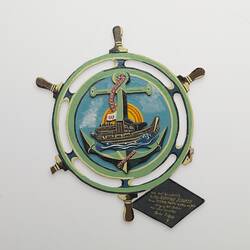Summary
Handpainted wooden ship wheel presented to Lachlan Kennedy, a member of the Australian Department of Immigration Indo-Chinese Refugee Taskforce, from January-September 1981. It was a gift from Duong Manh Hung, Chief of the Art Section, Camp Committee, Pulau Bidong Refugee Camp in Malaysia, 1981. It was one of three items made by Vietnamese refugees and given to Lachlan during his time at Pulau Bidong (along with two model refugee fishing boats made by Vietnamese refugee Tran van Hoang while waiting to be processed in Pulau Bidong Refugee Camp in Malaysia in 1981).
Refugees had art workshops in the camps, which catered to this wide spread interest by making handcrafts. Sungai Besi had a reputation for producing quality models of Vietnamese fishing boats of the kind used by refugees to escape Vietnam.
Manual activity was prolific in the camps, with people making items (often from recycled materials) needed by the camp residents. Some of the camps in northern Thailand had small 'gift shops' where immigration staff, visiting officials, or interview teams could purchase items. In these camps people plied their trades as best they could, utilising their expertise in such activities as gold and silver jewellery making, gemstone setting, wooden furniture making, hairdressing, dressmaking and tailoring, drawing and painting, and weaving (by Lao and Khmer refugees).
Physical Description
Painted wooden presentation plaque in the shape of a ship's wheel. Green, yellow and brown wheel and anchor with brown fishing boat, pink rope and yellow sun in background. White flag with 'SOS' inscribed. Small black plaque with inscription in yellow paint.
Significance
This important collection represents two sides of the asylum experience - the refugees and the government officials. These parallel and intersecting experiences have both personal and bureaucratic elements to them, linked by place, and world events, with craft and gifts of appreciation providing tangible points of connection and memory. The experiences of migration officials are frequently untold and unrepresented by material culture, as are material manifestations of refugee narratives. This collection enables the telling of both stories, with primacy given in this instance to the employee as custodian of the objects. The collection is also a symbol of a particular period in Australian migration history when support for refugee programs had both bipartisan and public support. Finally the theme of refugee, internee and detainee craft recurs across time and place and provides a tangible connection between very different human experiences, the trauma, economy and the tedium of which has been consistently alleviated through artistic practice.
More Information
-
Collecting Areas
-
Acquisition Information
Donation from Mr Lachlan Kennedy, 13 Dec 2014
-
Recipient
-
Inscriptions
'With Best Compliments/To: Mr Lachlan Kennedy/From: Duong Manh Hung KT 987/ Chief of Art Section/the camp committee/Pulau Bidong'
-
Classification
Migration, Processing - immigration selection, Refugee camps
-
Category
-
Discipline
-
Type of item
-
Overall Dimensions
230 mm (Width), 8 mm (Depth), 280 mm (Height)
-
Keywords
Vietnamese Immigration, Refugees, Crafts, Water Transport, Water Vessel, Boats, Model Boats, Models & Modelmaking, Art, Artistic Practices, Immigration, Immigrant Voyages, Immigration Selection, Awards, Vietnam War Refugees




